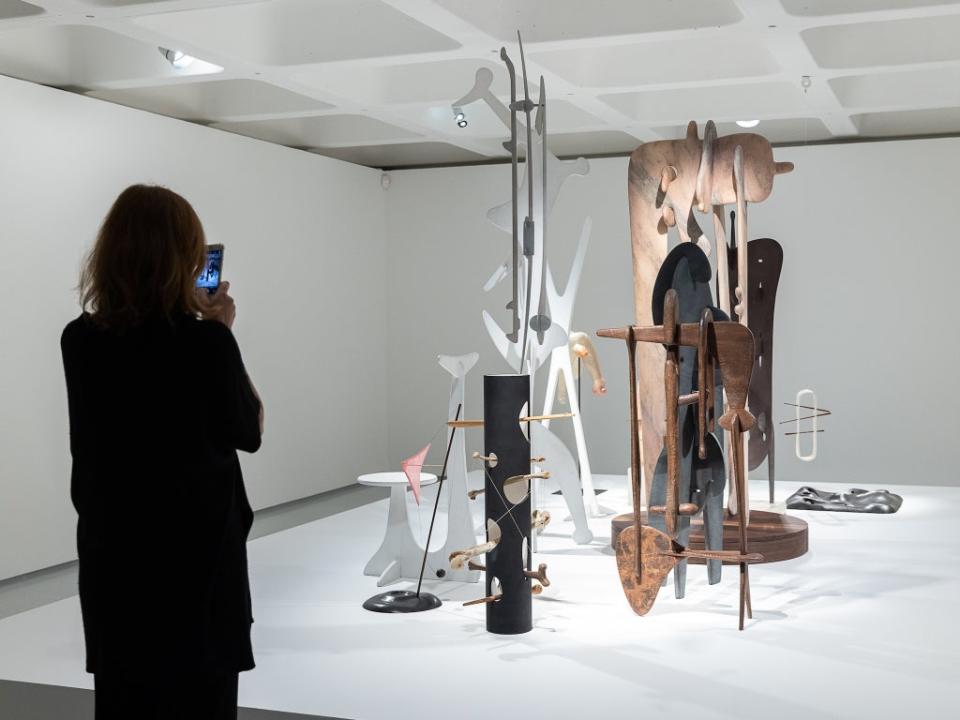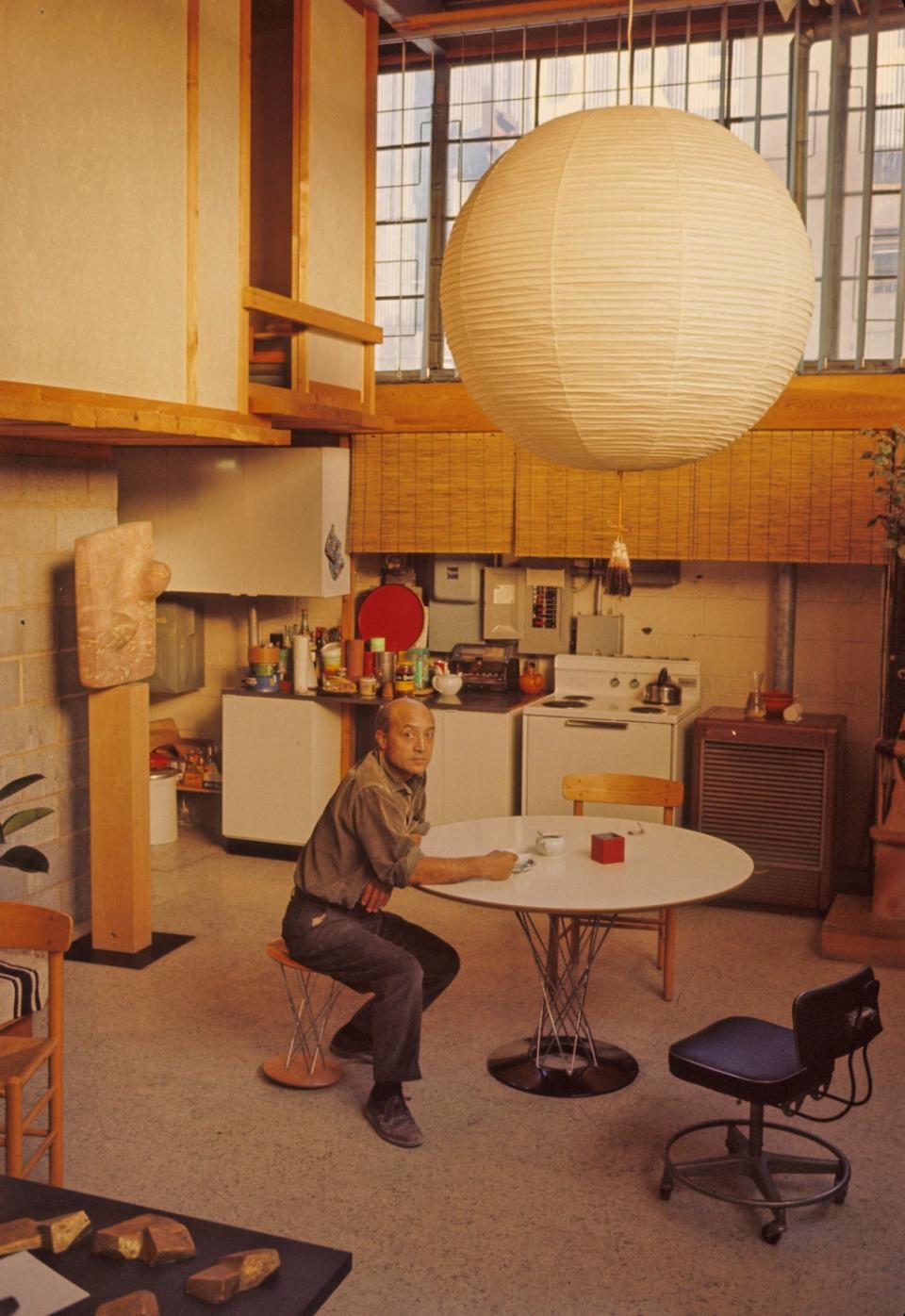Noguchi, Barbican, review: The unstoppable optimism of an undersung ‘total artist’

Chances are you’ll have lived with one of Isamu Noguchi’s artworks, possibly for much of your life, without ever realising it. The Japanese-American sculptor’s Akari light shades – fine spirals of bamboo covered in rice paper, first manufactured in 1951 – became some of the most ubiquitously available works created by any artist ever. Popularised by Habitat in Britain in the Sixties, they’re still available at Ikea, in a slightly bastardised pastiche form, which gives nonetheless a fair flavour of the original.
If you’re thinking, “Surely a paper light shade can’t be art”, or, “Sorry, is this an art or a design exhibition?”, you’re exactly the kind of person who needs to see this woefully undersung late artist’s first British show in 20 years. Encompassing sculpture, theatre, architecture, interiors, gardens and industrial design, it takes us to a post-war utopian moment when art, design and architecture were integrated in pursuit of a new world of light, space and social harmony.
And you don’t have to work to imagine yourself into this spirit: you step straight into it as you enter this Barbican exhibition. With the whole of the lower gallery opened up, a selection of the 200 versions of the Akari lampshade illuminates the space – glowing spheres; flattened ovoids; cubes; columns; hanging Akaris like paper concertinas lit from within; curving Akaris protruding from the floor like paper glow-worms – among an array of Noguchi sculpture in bronze, stone, clay and steel. If the effect is a bit like being in some ultra-minimalist, avant-garde lighting showroom circa 1958, that in itself feels like a privilege. And the intensity of light is subtly gradated so you move gradually from relative darkness to light, as though following the transition from night to day or the curvature of the Earth. And if that feels like a big idea, then Noguchi himself, born in Los Angeles in 1904, tended to aspire towards the universal.
“To be hybrid is to be the future,” he wrote in 1942 from the Arizona desert, where he was interned as an enemy alien during the Second World War, a statement that feels like a prediction of our current age of migration and self-transformation. The son of an estranged Japanese poet father and Irish-American writer mother, Noguchi endured a chaotic bohemian childhood that led to a life spent in permanent motion, between Japan, California, London, New York, China (where he studied traditional painting – some rather beautiful brush drawings are exhibited here) and Paris, where he served as assistant to the great Romanian sculptor Constantin Brancusi. If the early bronze, Globular, 1928, looks a little too much like classic Brancusi, the inclusion of a much later suspended paper light sculpture, Akari N7, 1955, shows how much its repeated “double pyramid” form owes to Brancusi’s seminal Endless Column from 1918: monumental form repurposed in a featherlight domestic sculpture that folds away into nothing.
While Noguchi saw himself as a permanent outsider, he gravitated easily into collaborations with some of the 20th century’s great innovators. He worked on Buckminster Fuller’s Dymaxion car, which the visionary architect and inventor intended would fly, and designed modern dance pioneer Martha Graham’s most revolutionary productions. The arching brass form of his Spider Dress from Graham’s Cave of the Heart, 1946, looks peculiar plonked in the gallery as art, with its protruding wires echoing both branches and the human nervous system, until you realise it’s intended to be worn, as a piece of performative kinetic sculpture.

His “lunars” series of wall-hanging sculptures from 1944 were similarly groundbreaking with the moon-like surfaces of the Arizona desert – observed during his internment – echoed in protruding forms in synthetic materials: white magnesite, plastic and fibreglass. Even more innovative was the incorporation of electric lights, which anticipated the Akari lampshade, a contemporary response to the traditional Japanese paper lantern. Lighting up red marble moonscapes or glowing from a ceiling in a pyramidal grid of paper and bamboo, Akari structures recur throughout the exhibition, suggesting a kind of universally accessible illumination that goes beyond the merely physical.
A completely different side of Noguchi is seen in some extremely strange sculptures created in the aftermath of Hiroshima. In Avatar, 1947, anthropomorphic shapes carved from sheets of pink marble architectural cladding slot into and hang over each other like suggestive body parts in works that don’t look much like any other art I can think of, unless maybe it’s Miro on drugs. Similar structures in wood look as though they’re trying to mutate into furniture even as you watch.

The Barbican’s monumental columns and distressed Brutalist surfaces make it the perfect setting for an exhibition that feels like a holiday in high modernist heaven. While there’s plenty of dark stuff here, not least a 1935 sculpture protesting against racist lynchings, the overriding mood is of unstoppable positivity and optimism. Noguchi’s instincts, formed at least in part by his Japanese background, lay towards harmony, wholeness and the spiritual integration of art and everyday life: that may set him apart from 20th century art’s preoccupation with problematic fragmentation, but it feels bang on the money with what we want art to do today.
Whether or not he ultimately proves to be one of the greats of sculpture, Noguchi was most interesting as a total artist, whose ideas about time, space and relativity are as evident in his children’s playgrounds, garden designs and an early plastic baby monitor he put into production in 1937, as in anything he created to be put in a gallery.
Noguchi, Barbican Art Gallery, until 9 January
Read More
Theaster Gates: A Clay Sermon review – These room-filling installations tend towards the epic
Turner Prize 2021 – Art comes in second to the happy-clappy spirit of lockdown
Mixing It Up: Painting Today is a big, punchy show with an upbeat vibe – review
Ben Nicholson’ story illuminates the struggle of British culture to revitalise itself – review

